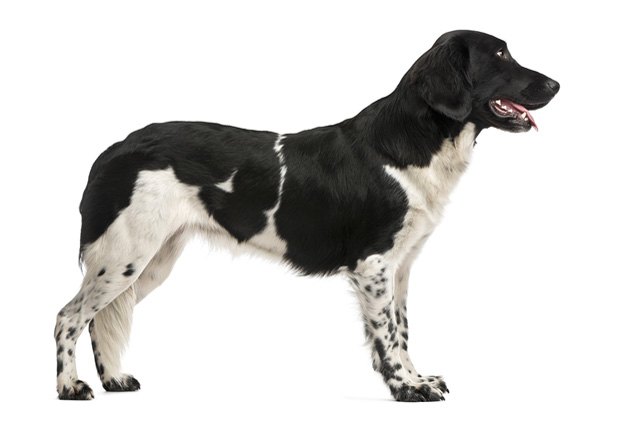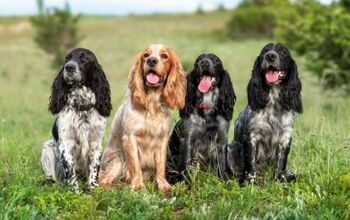Stabyhoun


About Stabyhoun
Also known as the Dutch Stabyhoun, the Stabij or the Friesian Pointer, the Stabyhoun is a medium-sized dog with a long black-and-white coat. This breed is one of the top five rarest breeds in the world (as of 2013) and its breeding is closely regulated by the Dutch Association for Stabyhouns and Wetterhouns. It is estimated that there are only about 3,500 Stabyhouns in existence and they are still fairly rare outside the Netherlands. This breed is an excellent pointing breed and it is highly intelligent and obedient. If you are looking for a loyal and friendly breed that is great with children and eager to please, the Stabyhoun may be the right option for you (that is, if you can find one!).
The Stabyhoun is a medium-sized dog with a long black-and-white coat.
Some of the earliest mentions of the Stabyhoun breed date back to the early 1800s in historic literature by Joost Halbertsma and Nynke fan Hichtum. This breed was developed to hunt foxes, birds, and other small game – they were particularly skilled in catching moles. The modern Stabyhoun remains a talented hunter, primarily used as a tracker, pointer, and watchdog. The Stabyhoun is one of the rarest breeds in the world and it has a small but loyal following among Dutch homeowners and sportsmen, valued for its hunting skills as well as its guarding capabilities.
The exact origins of the Stabyhoun are unknown so it is unclear what other breeds may have played a role in the breed’s development. Modern Stabyhouns are sometimes bred with Labradors because they are so similar in behavior, temperament, and physique.
The Stabyhoun is a medium-sized breed and should be offered a dog food formulated for dogs of its size. This breed is also active so you may want to consider switching to an active breed formula. This type of food will help to ensure that your dog’s daily needs for energy are met.
The Stabyhoun is an intelligent breed which makes it highly trainable.
The Stabyhoun is an intelligent breed which makes it highly trainable. Because these dogs are somewhat independent by nature, however, they require a firm and consistent hand in training. It is recommended that you use positive reinforcement-based training methods with this breed and that you start training and socialization as early as possible.
The Stabyhoun is a medium-sized breed that stands 19 to 21 inches tall and weighs between 40 and 55 lbs. on average.
The Stabyhoun makes for a very gentle and devoted family pet – this breed is good around children because it tends to be patient and tolerant. This breed is very intelligent so it does require plenty of mental stimulation to prevent the development of problem behaviors. The Stabyhoun is friendly by nature and eager to please. Even though this breed is a hunting breed, it tends to get along well with other household pets and it is generally not aggressive or dominant toward other dogs. The Stabyhoun makes a good watch dog, even though it is very amiable by nature.
The breeding stock for the Stabyhoun is small and closely regulated by the Dutch Association for Stabyhouns and Wetterhouns to keep the breed in good health. There are some small populations of this breed outside the Netherlands, but the greatest genetic diversity for the breed exists in the Netherlands. Prior to breeding, both the male and female stock dogs are evaluated with hip x-rays and they must be cleared by the Dutch Club. Female Stabyhouns are only allowed to birth 5 litters in their lifetime and they cannot be bred before 18 months of age or after 9 years of age. As a result of these policies, this is a healthy breed not prone to developing serious health problems. The only problem that has not been bred out is hip dysplasia and careful breeding practices are in place to reduce the instance of this disease.
The average lifespan for the Stabyhoun is about 13 to 14 years.
As a hunting breed, the Stabyhoun requires a significant amount of daily exercise to remain in good health. This breed is also intelligent so it needs both physical and mental stimulation on a daily basis. This dog requires a long daily walk and it will appreciate some active playtime or having a large fenced yard to run around in.
The Stabyhoun makes for a very gentle and devoted family pet – this breed is good around children because it tends to be patient and tolerant.
The Stabyhoun is not yet recognized by the AKC but it is part of the Foundation Stock Service. When sufficient numbers are available it will become fully recognized.
The Stabyhoun has a medium-length silky coat of black and white fur, though brown-and-white coloration is possible. Orange and white-coated Stabyhouns are also acceptable but they are becoming increasingly rarer. This breed is clean by nature though regular brushing is recommended to ensure proper coat health and to prevent tangles and mats. This breed molts twice per year – during these periods, extra brushing is recommended.
The average litter size for the Stabyhoun breed is about 7 puppies. Breeding for Stabyhouns is closely monitored by the Dutch Club to ensure integrity of the breed. Females are not allowed to birth more than 5 litters in their lifetime and males are not permitted to sire more than 3 litters per year.
Photo credit: eriklam/Bigstock.com; Life on White/Bigstock.com

Kate Barrington is the loving owner of two cats (Bagel and Munchkin) and a noisy herd of guinea pigs. Having grown up with golden retrievers, Kate has a great deal of experience with dogs but labels herself a lover of all pets. Having received a Bachelor's degree in English, Kate has combined her love for pets and her passion for writing to create her own freelance writing business, specializing in the pet niche.
More by Kate Barrington

























